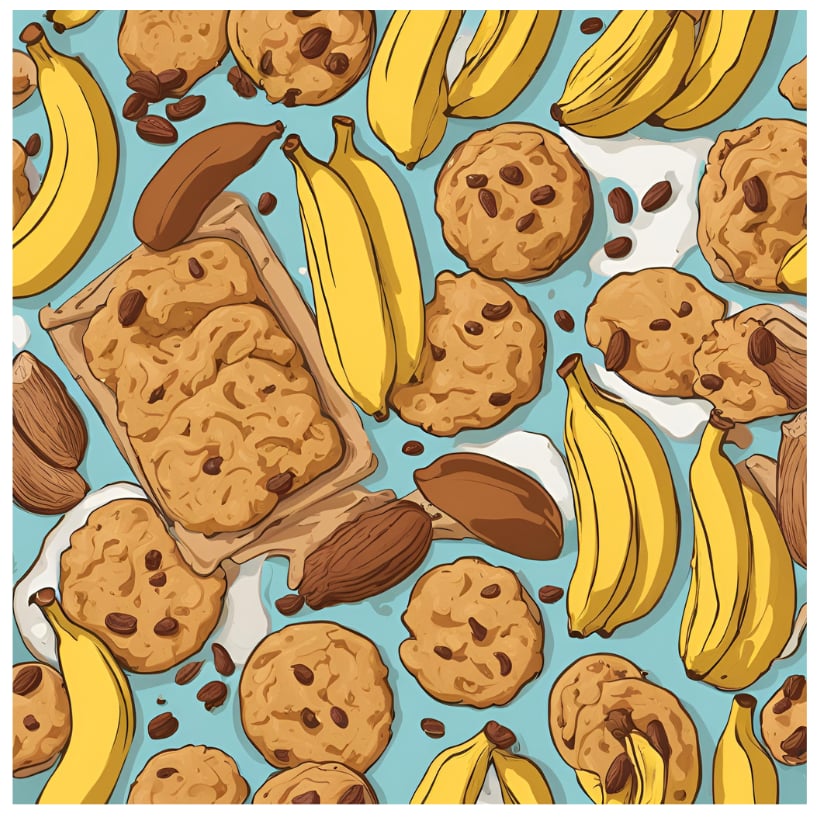การบูรณาการการเรียนรู้เคมีในกระบวนการผลิตอาหารเพื่อสุขภาพ : กรณีศึกษาการพัฒนาคุกกี้อินทผลัมและคุกกี้กล้วยน้ำว้า
คำสำคัญ:
การบูรณาการเคมี, อาหารเพื่อสุขภาพ, คุกกี้อินทผลัม, คุกกี้กล้วยน้ำว้าบทคัดย่อ
การพัฒนาผลิตภัณฑ์อาหาร ผู้ผลิตและนักพัฒนายังขาดความรู้เกี่ยวกับการประยุกต์ใช้เคมี ซึ่งส่งผลต่อคุณภาพและคุณค่าทางโภชนาการของผลิตภัณฑ์ งานวิจัยนี้มีวัตถุประสงค์เพื่อบูรณาการการเรียนรู้ด้านเคมีในกระบวนการผลิตอาหารเพื่อสุขภาพ โดยศึกษาและพัฒนาสูตรคุกกี้อินทผลัมและคุกกี้กล้วยน้ำว้า ด้วยการลดปริมาณน้ำตาลและประเมินคุณภาพทางประสาทสัมผัส คุณภาพทางเคมี และคุณภาพทางกายภาพ สูตรที่พัฒนาขึ้นมีสัดส่วนอินทผลัมและกล้วยน้ำว้า 260 กรัมต่อน้ำตาล 150 กรัม ซึ่งได้รับการยอมรับจากผู้บริโภค ผลการประเมินคุณภาพทางประสาทสัมผัสแสดงให้เห็นว่าคุกกี้อินทผลัมและกล้วยน้ำว้ามีคะแนนความชอบอยู่ในระดับปานกลางถึงชอบมาก โดยมีค่าเฉลี่ย 4.24 ± 0.72 และ 4.16 ± 0.68 ตามลำดับ นอกจากนี้ การวิเคราะห์คุณภาพทางเคมีพบค่าร้อยละความชื้นของอินทผลัมและกล้วยน้ำว้าอยู่ที่ 1.04 และ 1.18 ตามลำดับ ซึ่งแสดงถึงศักยภาพในการใช้ผลไม้เหล่านี้ในผลิตภัณฑ์อาหารที่ตอบสนองความต้องการของผู้บริโภค การศึกษานี้จึงยืนยันถึงความสำคัญของการนำความรู้ทางเคมีมาประยุกต์ใช้ในการพัฒนาสูตรอาหารที่มีคุณภาพสูงและเหมาะสมต่อสุขภาพอย่างมีประสิทธิภาพ
References
จิระนาถ รุ่งช่วง & นภัศรพี เหลืองสกุล. (2561). การพัฒนาผลิตภัณฑ์คุกกี้จากแป้งปราศจากกลูเตนบางชนิด. วารสารการพัฒนาผลิตภัณฑ์อาหาร. 14(1). 47-56.
ซุลฟาร์ บาโด และ ซูซานา เบนมีนา. (2562). การวิเคราะห์ค่าสถิติในงานวิจัยอาหาร. วารสารวิทยาศาสตร์การ อาหาร. 17(2). 44-50.
ธิดารัตน์ เปรมประโสพโชค, ศศิธร จานเก่า, & ประไพรภัส ทาน้อย. (2557). การทดแทนน้ำตาลทรายในคุกกี้ด้วยกล้วยน้ำว้า. วารสารวิจัยอาหาร. 7(3). 45-53.
นรินทร์ เจริญพันธ์. (2561). การพัฒนาผลิตภัณฑ์คุกกี้จากมันเทศ. วารสารเทคโนโลยีอาหาร. 12(2). 97-103.
นาดียะฮ์ มะยูนุ และ ฮุสนา ดากอฮา. (2562). การวิเคราะห์ค่าสีของผลิตภัณฑ์คุกกี้เพื่อสนับสนุนผู้ประกอบ การ. วารสารการพัฒนาอุตสาหกรรมอาหารชุมชน. 5(1). 20-28.
วิภาวรรณ วงศสุดาลักษณ์. (2559). การพัฒนาผลิตภัณฑ์คุกกี้เสริมเส้นใยอาหารจากซังจำปาดะ. วารสาร วิทยาศาสตร์และเทคโนโลยีอาหาร. 11(1). 21-29.
สิรินทรา สิทธิชัยวงศ์, ปรเมศ ศรีแก้ว, หริพล ธรรมนารักษ์, & สมอ บุญพันธ์. (2563). การพัฒนาผลิตภัณฑ์คุกกี้กรอบด้วยวัตถุดิบแตกหักจากกระบวนการบรรจุหีบห่อกล้วยทอดกรอบ. วารสารวิทยาศาสตร์อาหารและเทคโนโลยี. 19(1). 73-85.
อมรรัตน์ ถนนแก้ว. (2551). การพัฒนาผลิตภัณฑ์คุกกี้เสริมแพคตินจากเปลือกมะนาว. วารสารการพัฒนา ผลิตภัณฑ์อาหาร. 4(2). 56-63.
Al-Qarawi, A. A., Mufeed, R. I., & Rehman, A. (2020). Nutritional and health benefits of dates: A review. Journal of Food Science and Technology. 57(5). 1834-1841.
Alkhalidy, H., Ali, M., & El-Agamy, E. (2021). Evaluation of the chemical and sensory properties of cookies made with date palm fruit. Food Science & Nutrition. 9(6), 3232-3240.
AOAC. (2000). Official Methods of Analysis (17th ed.). Washington, DC: Association of Official Analytical Chemists.
Chaiyawat, M., & Chongsuvivatwong, V. (2021). The prevalence of sugar-sweetened beverage consumption and its association with metabolic diseases in Thai adults: A nationwide survey. BMC Public Health. 21(1). 1234.
Chowdhury, S. A., Rahman, M. M., & Hossain, M. S. (2021). Nutritional composition and health benefits of banana: A review. Journal of Nutritional Health & Food Engineering. 11(1). 51-59.
Drewnowski, A., & Almiron-Roig, E. (2010). Human perceptions and preferences for fat-rich foods. In Food chemistry and nutrition (pp. 215-234). CRC Press.
Fadimu, G. J., & Adebayo, A. H. (2022). Phytochemical properties and nutritional value of banana (Musa spp): A review. Food Science and Nutrition. 10(4). 960-973.
Farah, H. M., Omar, S., & Zainudin, A. (2022). Nutritional composition of whole wheat cookies enriched with banana and date pulp. International Journal of Food Science, 2022, 1-9.
García, M. C., Diego, P., & Montoya, L. (2020). Integrating chemistry knowledge in food product development. Chemistry and Food Science. 4(1). 100-111.
García, O., Aizawa, M., & Narváez-Cuenca, C. (2020). The role of chemistry in food safety and quality. Food Chemistry, 345, 128835.
Ghoshal, G., & Gupta, R. (2015). Impact of sugar reduction on the sensory and physicochemical properties of bakery products. Journal of Food Processing and Preservation. 39(6). 1312-1320.
Hayiyakoh, K., & Japrang, T. (2024). Market opportunity and potential of halal instant food products in Pattani province. Al-Nur Journal of Graduate Studies. 19(36). 144-147.
Ibrahium, M. I., Hegazy, E. S., & Amin, M. A. (2016). Effect of sugar substitution by date palm puree on the quality of cookies. Journal of Food Science and Technology. 53(2). 1213-1220.
Katz, D. L., Doughty, K., & Ali, A. (2011). Sugar reduction: A systematic review of the evidence for sustained behavior change and weight loss. American Journal of Clinical Nutrition. 94(1). 5-10.
Liu, R. H. (2003). Health benefits of fruits and vegetables are from additive and synergistic combinations of phytochemicals. The American Journal of Clinical Nutrition, 78(3). 517S-520S.
López-Castillo, M. A., & Montalvo-González, E. (2018). Chemical and nutritional aspects of functional foods: An overview. Food Science and Technology International. 24(7). 610-624.
Mansoori, P., Khan, M. I., & Khattak, M. (2021). Effect of various natural sweeteners on the sensory properties and quality of cookies. International Journal of Food Science & Technology, 56(5). 2785-2792.
McClements, D. J. (2017). Food structure and functionality: How structural design affects food quality and stability. Comprehensive Reviews in Food Science and Food Safety. 16(2). 220-232.
McClements, D. J. (2017). Understanding the science behind food chemistry. Annual Review of Food Science and Technology. 8(1). 31-52.
Micha, R., Peñalvo, J. L., Cudhea, F., Imamura, F., Rehm, C. D., & Lichtenstein, A. H. (2017). Association between dietary factors and mortality from heart disease, stroke, and type 2 diabetes in the United States. JAMA Internal Medicine. 177(10). 1455-1465.
Miller, R. J., Jones, D. E., & Salinas, M. (2023). Chemical assessment of food products: Implications for consumer health. Journal of Food Science and Technology. 60(2). 563-578.
Noor Aziah, A. A., Mohamad Noor, Y., & Ho, L. H. (2012). Physicochemical and organoleptic properties of cookies incorporated with legume flour. International Food Research Journal. 19(4). 1539-1543.
O’Brien, L. M., & O’Brien, C. (2008). Understanding the importance of water in cookie production. Journal of Food Quality. 31(4). 474-487.
Smadi, M., Makhzoumi, M., & Al-Sharif, I. (2020). Health benefits of dates as a natural sweetener in baked products. Food Quality and Preference, 10(3). 75-90.
Su, X., & Flores, R. A. (2017). Effect of sugar and fat reduction on the texture of cookies: Measurements and modeling. Journal of Food Engineering, 63(2). 133-176.
Suwannapong, P., & Phetphum, T. (2020). The rising burden of non-communicable diseases related to high sugar intake in Thailand. Thai Journal of Public Health. 50(2). 78-85.
Wang, C. K., & Huang, Y. C. (2022). Sugar consumption and metabolic syndrome: A review of recent studies in Thailand. Journal of Nutrition and Metabolism, 2022, Article ID 987654.
Zhao, H., Wang, Y., & Zha, Y. (2021). Health benefits of date palm (Phoenix dactylifera L.): A review. Journal of Functional Foods. 18(6). 2775-2780.

Downloads
เผยแพร่แล้ว
ฉบับ
บท
License
Copyright (c) 2025 Muhammad Ameen Hadjihama, Yakoh Khareemdabe, Amina Samae

This work is licensed under a Creative Commons Attribution-NonCommercial-NoDerivatives 4.0 International License.
Proposed Creative Commons Copyright Notices
